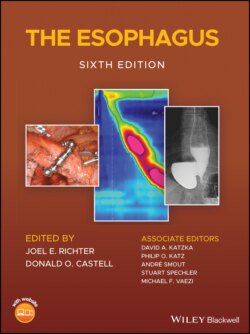Читать книгу The Esophagus - Группа авторов - Страница 215
Manometry study technique and protocol The HRM assembly
ОглавлениеHigh‐resolution manometry assemblies are commercially available through several different manufacturers, each with proprietary analysis software to generate EPT plots and facilitate analysis. Regardless of manufacturer, each HRM assembly entails 30–36 pressure sensors spaced 1–2 cm apart incorporated into a flexible catheter. Because differences in catheter and pressure‐sensor technologies affect the performance characteristics of the device, it is important that clinical interpretation should be based upon normative values generated with the specific apparatus utilized. These differences in performance are particularly relevant with measurement of deglutitive lower esophageal sphincter (LES) relaxation, i.e. the integrated relaxation pressure (IRP); see Table 8.1 [8].
Table 8.1 Normal values by HRM assembly manufacturer. Values reflect 5 ml liquid bolus swallows performed in the supine patient position.
Source: Based on Herregods, Roman, Kahrilas, et al. [8].
| HRM | Sierra‐vintage | MMS – Unisensor AG | Sandhill – Unisensor AG | Starlet – Unisensor AG |
|---|---|---|---|---|
| N, asymptomatic controls | 75 [22, 33, 35] | 52 [94] | 69 [95] | 97 [96] |
| IRP (mmHg) 95th percentile | 15 | 28 | 23.5 | 20 |
| Basal EGJ pressure * (mmHg) 5th–95th percentile | 5–32 | 9–51 | 8–62 | 15–48 |
| DCI (mmHg•s•cm) 5th–95th percentile | 448–4721 | 186–3408 | 606–4998 | 1413–6844 |
| Distal latency (seconds) 5th percentile | 4.3 | 5 | 5.1 | 5.8 |
* At end‐expiration.
High‐resolution impedance manometry (HRIM) catheters additionally incorporate serially spaced impedance channels, generally with 2 cm spacing. Impedance measurements relate to the content of the esophagus such that impedance decreases with intraluminal liquid and increases with intraluminal air. Hence, high‐resolution impedance recordings can detect the entrance of an esophageal bolus by a decrease in impedance and bolus clearance when the impedance signal returns to baseline [9]. Utilization of HRIM then provides a method to objectively assess bolus transit, bolus clearance, intrabolus pressure, and relationships between esophageal pressure and bolus flow [10–13]. However, despite this additional information, the clinical utility of impedance manometry beyond what is learned from HRM remains a topic of debate. Further discussion of the utilization of HRIM follows.
